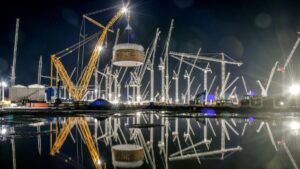
Ministers are backing a multibillion-pound plan to build another large-scale nuclear power plant in Britain to ease pressure on electricity supplies as the country moves towards net zero.
The government is in discussions with the American nuclear reactor manufacturer Westinghouse about a proposal to develop a new plant on Anglesey in north Wales.
The project would be in addition to a second nuclear plant at Hinkley Point, Somerset, which is under construction, and a proposal for a new reactor at Sizewell, Suffolk, that is at an advanced stage of planning.
If it gets the go-ahead the new plant at Wylfa would be able to generate enough electricity to power more than six million homes and could be operational in the mid-2030s.
Ministers are understood to be increasingly concerned that existing nuclear projects will not provide the power needed to meet carbon reduction targets.
Britain’s seven nuclear plants provide about 17 per cent of its electricity needs but this will fall by almost half by 2024. Further plants are due to shut between then and 2030 and, even with the new Hinkley Point — which is due to come online in 2027 and will power about six million homes — the proportion of nuclear energy in the grid will fall.
The development of new nuclear power stations in Britain has had a long and troubled history, but replacement plants are important for the future, according to the government’s climate advisers. Britain’s electricity system needs to be decarbonised by 2035 to reach net zero by 2050.
Senior government sources said that Kwasi Kwarteng, the business secretary, is concerned that, under present plans, by the early 2030s the proportion of nuclear power on the grid will be insufficient to provide a reliable “baseload” as gas power stations are phased out.
He is understood to be backing plans to build the new plant at Wylfa and is lobbying the Treasury for a funding mechanism that would attract private investment. The government has committed to taking a final investment decision on at least one new nuclear power plant by 2024. However, sources said there was growing backing to give the go-ahead to two. An attempt to build a nuclear plant at Wylfa collapsed last September after the Japanese company Hitachi pulled out.
A senior government source said the recent rise in gas prices that has coincided with unusually low winds speeds in the North Sea had underlined the need to invest more in nuclear. “If our current situation shows anything it is that we need more stable home grown, low carbon generation in the UK,” the source said. “This is an important project that we’re very keen to try and get off the ground.”
The project is also being pushed by Simon Hart, the Welsh secretary, who has argued it would fit into the government’s levelling-up agenda and provide hundreds of high-skilled jobs to a part of the country in need of regeneration.
Speaking to MPs yesterday Barbara Rusinko, president of nuclear at the engineering firm Bechtel that is part of the Wylfa consortium, said the involvement of a US company in the project’s development would “strengthen the transatlantic security partnership”.
But she warned that ministers would need to provide initial support to find a developer who would run the plant and raise the capital to start construction. “We need the UK government to demonstrate backing for the project through commitment in the comprehensive spending review,” she said.
Two attempts to build new plants in recent years fell by the wayside. In 2018 Toshiba scrapped plans for a new nuclear station in Cumbria after concluding that it did not have the financing in place to complete the project. The following year Hitachi pulled out of financing a new plant in north Wales on the same site that is now being looked at again by the government.
Both of those schemes foundered in part because of difficulties in finding the long-term finance to make them viable.
Under the previous system the government tried to incentivise investment by agreeing to pay a set price for the energy generated by the plants when they were up and running.
But while being cheap to run, new nuclear reactors can cost more than £20 billion to build and have in the past been highly susceptible to delays and cost overruns. For institutional investors, the risk was simply too great.
Even Hinckley was at one stage in doubt but survived because EDF is 80 per cent owned by the French government.
Last year the government consulted on a new funding model for large-scale projects such as nuclear plants that would allow investors a return on their money before the plant was operational. The idea is that it would “derisk” nuclear development and allow operators the ability to raise the finance to pay for them.
Critics say that the plan would transfer all the risk of delays and cost overruns on to the taxpayer. But with the government’s 2050 net zero target enshrined in law and the work of delivering it about to begin in earnest, there is a recognition in government that the failures of the past cannot be repeated.
Read more:
US company in talks to build new nuclear power plant near Holyhead
